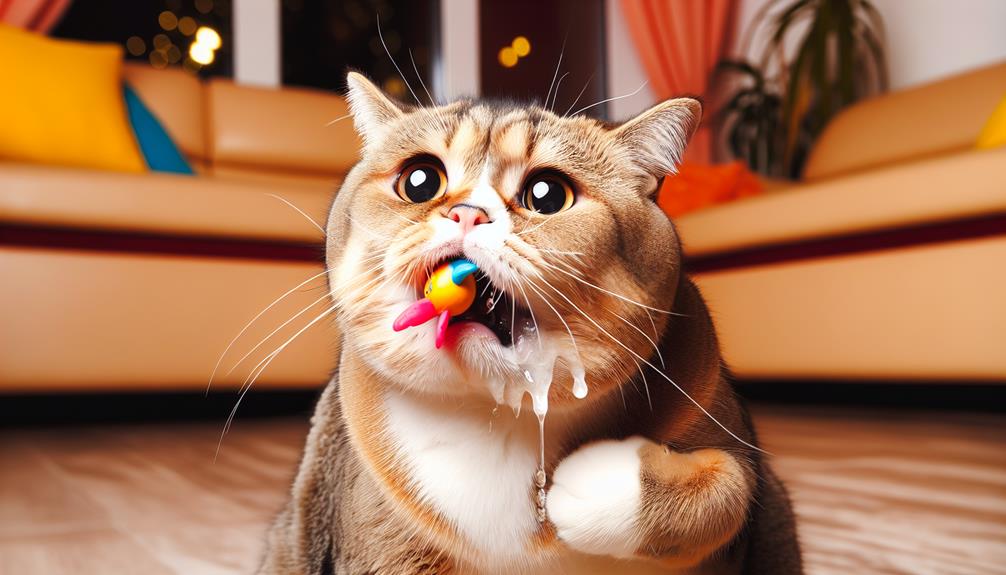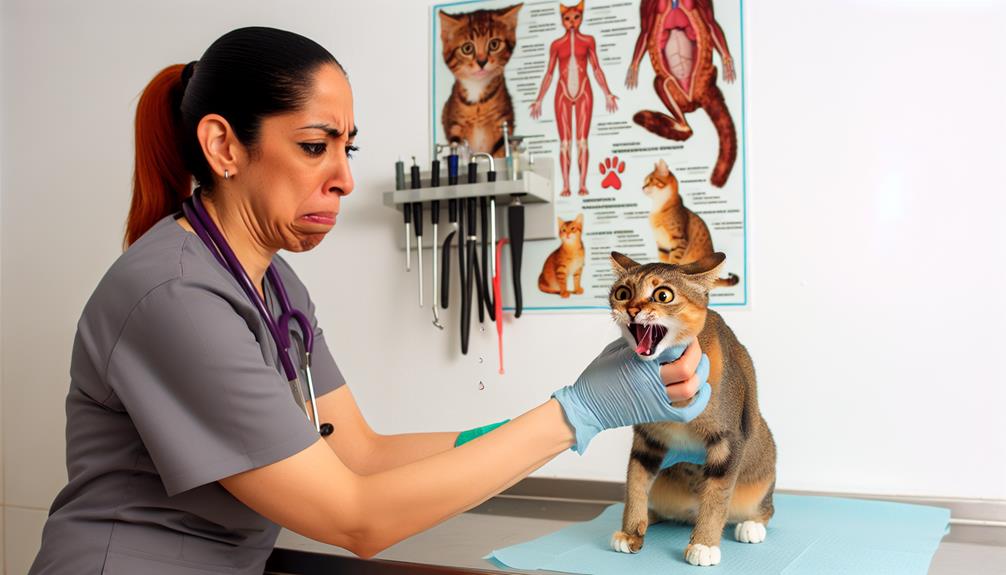Imagine your car's check engine light flickering on; it's a small warning of a potentially larger issue. When your cat starts drooling, it's like that warning light, hinting at dental problems, oral infections, or even something lodged in their mouth. You might notice other signs like vomiting or lethargy, which can be concerning. Understanding the various causes behind this drooling could help you determine when to seek veterinary care and guarantee your furry friend stays healthy and comfortable. So, what exactly might be triggering that unexpected drool?
Dental Issues
When it comes to your cat's drooling, dental issues are often a primary culprit. Poor dental hygiene can lead to various problems, including gum disease, which can cause excessive salivation. If your cat's teeth aren't regularly cleaned, plaque and tartar can accumulate, resulting in gingivitis. Gingivitis is the inflammation of the gums, a condition that can make your cat's mouth sore and lead to drooling.
To diagnose dental issues, a thorough oral examination by your veterinarian is essential. They'll look for signs of gingivitis, such as redness, swelling, and bleeding gums. Advanced gum disease, known as periodontitis, can also be a factor. In periodontitis, the inflammation extends deeper into the tissues supporting the teeth, often leading to tooth loss if untreated. Your vet might perform a dental radiograph to assess the extent of the damage and determine the appropriate treatment.
You can manage and prevent dental issues with regular dental hygiene practices. Brushing your cat's teeth with feline-appropriate toothpaste and providing dental treats can greatly reduce plaque buildup. Your veterinarian may also recommend professional dental cleanings under anesthesia to thoroughly clean and polish your cat's teeth and address any underlying issues.
Oral Infections
Oral infections can be another significant reason your cat might be drooling. These infections often stem from conditions such as gingival disease and feline stomatitis, both of which can cause substantial discomfort and excessive salivation.
Gingival disease, commonly referred to as periodontal disease, is an inflammation of the gums caused by bacterial plaque. When plaque isn't regularly removed, it hardens into tartar, leading to gingivitis. Symptoms include red, swollen gums that bleed easily, and if left untreated, it can progress to periodontitis. This advanced stage can damage the structures supporting your cat's teeth, causing pain, tooth loss, and increased drooling.
Feline stomatitis is another severe oral condition characterized by widespread inflammation and ulceration of the oral tissues. This disease can affect the gums, tongue, and the back of the mouth, causing intense pain and hypersalivation. The exact etiology of feline stomatitis isn't fully understood, but it's believed to involve an abnormal immune response to plaque bacteria. Identifying feline stomatitis requires a detailed oral examination, and in some cases, biopsy and histopathology may be necessary to confirm the diagnosis.
When diagnosing oral infections in cats, veterinarians will typically perform a thorough oral examination, often under anesthesia to fully assess the extent of the disease. Dental radiographs are also vital for evaluating the health of tooth roots and surrounding bone. Treatment for gingival disease might include professional dental cleaning, scaling, and polishing, followed by at-home care. Managing feline stomatitis often requires a combination of medical treatments, such as antibiotics and anti-inflammatory medications, and in severe cases, surgical intervention like tooth extractions.
Addressing these oral infections promptly is essential to alleviate your cat's discomfort and prevent further complications.
Foreign Objects

If your cat is drooling, consider the possibility of a foreign object lodged in their mouth or throat. Common culprits are small ingested items like strings or pieces of toys, which can cause significant oral trauma. Look for signs such as excessive salivation, pawing at the mouth, or difficulty swallowing, and seek veterinary evaluation promptly.
Ingested Small Items
Cats occasionally ingest small items that can become foreign objects lodged in their gastrointestinal tract, often leading to drooling. These ingested toys or other small items can cause a gastrointestinal blockage, which may present with additional symptoms like vomiting, decreased appetite, and lethargy. Immediate veterinary evaluation is vital to diagnose and treat this condition effectively.
To assess if your cat has ingested a foreign object, your veterinarian might perform:
| Diagnostic Tool | Purpose |
|---|---|
| Physical Examination | Initial assessment of symptoms |
| Abdominal X-rays | Visualize foreign objects |
| Ultrasound | Detailed imaging of soft tissues |
| Blood Tests | Check for infection or organ dysfunction |
| Endoscopy | Direct visualization and potential removal of object |
A gastrointestinal blockage can be life-threatening and often requires surgical intervention. During the physical exam, your vet will palpate your cat's abdomen to detect any abnormal masses or pain. Abdominal radiographs and ultrasounds provide significant insights into the location and nature of the obstruction. Blood tests are essential to evaluate your cat's overall health and identify any concurrent issues. In some cases, an endoscopy might be employed to both diagnose and retrieve the ingested foreign object without invasive surgery. Always be vigilant about keeping small items out of your cat's reach to prevent such incidents.
Oral Trauma Signs
You might notice your cat drooling if they've sustained oral trauma from foreign objects. Common culprits include splinters, fish bones, or pieces of toys. Such objects can lodge between teeth, puncture the gums, or become embedded in the soft tissues of the mouth. This leads to excessive salivation, discomfort, and even bleeding.
To diagnose oral trauma, you should look for other signs like pawing at the mouth, reluctance to eat, or visible swelling. A thorough examination by a veterinarian is essential. They'll likely perform a physical inspection and may use dental radiographs to detect any hidden objects or structural damage. Early detection is key to preventing more severe complications such as infections or abscesses.
Maintaining your cat's oral hygiene can greatly reduce the risk of trauma. Regular dental check-ups and appropriate chew toys are crucial for trauma prevention. Avoid giving your cat small, brittle items that could break apart and cause injury. If you suspect your cat has a foreign object lodged in their mouth, prompt veterinary attention is necessary. Timely intervention will not only alleviate your cat's discomfort but also prevent further health issues.
Nausea and Vomiting
Nausea and vomiting in cats can be distressing for both the feline and its owner, often signaling underlying health issues that require prompt attention. When your cat is experiencing nausea, you might notice changes in its behavior such as increased salivation, restlessness, or frequent swallowing. These signs may be exacerbated by stress factors, including changes in the environment or routine, which can contribute to gastrointestinal upset.
To effectively address these symptoms, it's vital to understand the potential underlying causes. Here's a diagnostic approach to take into account:
| Symptom | Possible Cause |
|---|---|
| Chronic Vomiting | Gastrointestinal Disorders |
| Acute Vomiting | Dietary Indiscretion |
| Associated Diarrhea | Inflammatory Bowel Disease |
| Lethargy | Systemic Illness |
Chronic vomiting often points to gastrointestinal disorders such as gastritis, pancreatitis, or even foreign body ingestion. Acute vomiting might be linked to dietary indiscretion, where your cat has consumed something inappropriate, leading to gastrointestinal irritation. If vomiting is accompanied by diarrhea, conditions like inflammatory bowel disease (IBD) should be taken into account. Lethargy alongside vomiting can indicate a systemic illness, necessitating thorough diagnostic workup including blood tests, imaging, and potentially endoscopy.
Your veterinarian will likely conduct a detailed physical examination and may recommend specific diagnostic tests to pinpoint the exact cause of the vomiting and drooling. Managing stress factors such as providing a stable environment and minimizing abrupt changes can also play a vital role in alleviating these symptoms.
Prompt veterinary consultation is imperative to guarantee that your feline companion receives the appropriate treatment and care, thereby mitigating the distress caused by nausea and vomiting.
Poisoning and Toxins

When it comes to identifying the cause of your cat's drooling, poisoning and toxins should be considered as potential culprits. Cats are curious creatures, often exploring their environment with little regard for the dangers that may lurk within it. Toxic plants and chemical exposure are common sources of poisoning in felines, leading to excessive salivation as a symptom.
If you suspect your cat has been exposed to a toxic substance, immediate veterinary attention is essential. Common signs of poisoning, in addition to drooling, include:
- Vomiting: A desperate attempt by your cat's body to expel the toxin.
- Lethargy: Your cat may display a lack of energy or reluctance to move.
- Seizures: Severe poisoning can lead to neurological symptoms such as seizures.
Toxic plants like lilies, azaleas, and poinsettias are highly dangerous if ingested. Even small amounts can cause significant harm. Chemical exposure, whether from household cleaners, pesticides, or antifreeze, poses a serious risk as well. These substances can cause oral irritation, gastrointestinal distress, and other systemic issues.
In a clinical setting, diagnosing poisoning involves a thorough history-taking to ascertain potential exposure sources. Blood tests and urinalysis are often conducted to identify the toxin and assess the extent of organ involvement. Treatment protocols depend on the specific toxin but may include induced vomiting, activated charcoal administration, and supportive care such as intravenous fluids and medications to stabilize your cat's condition.
Always keep potentially toxic items out of reach and educate yourself on common household hazards. Prevention is the best approach to protect your feline friend from poisoning and the distressing symptoms that come with it.
Underlying Health Conditions
Beyond environmental hazards, underlying health conditions can also manifest as drooling in felines. When your cat exhibits excessive salivation, it may indicate a deeper issue such as salivary gland dysfunction, dental disease, or gastrointestinal disorders. Understanding these potential health problems is essential for ensuring the well-being of your pet.
Salivary gland dysfunction can severely impact your cat's drooling. Issues like sialadenitis (inflammation of the salivary glands) or salivary gland tumors can cause persistent drooling. Diagnostic imaging, such as ultrasound or MRI, is often employed to assess these conditions.
Feline stress factors can also be a significant contributor. Stress-induced hypersalivation, or ptyalism, might occur due to changes in the environment, new pets, or even routine disruptions. Behavioral observation and a thorough history can aid in identifying stress-related drooling.
Additionally, systemic illnesses such as kidney disease or hepatic lipidosis can lead to nausea, which often manifests as drooling. Blood tests and urine analysis are fundamental diagnostic tools to uncover these conditions.
| Condition | Symptoms | Diagnostic Approach |
|---|---|---|
| Salivary Gland Dysfunction | Swelling, pain | Ultrasound, MRI |
| Dental Disease | Bad breath, oral pain | Oral examination, X-rays |
| Gastrointestinal Disorders | Vomiting, weight loss | Blood tests, endoscopy |
| Feline Stress Factors | Behavioral changes | Behavioral observation |
Prompt veterinary consultation is necessary for an accurate diagnosis. Identifying the root cause of your cat's drooling allows for targeted treatment, whether it's managing stress, addressing dental issues, or treating systemic diseases. Don't overlook persistent drooling; it often signals an underlying health condition that requires professional attention.
Conclusion
If your cat's drooling, it could be due to dental issues, oral infections, or even something more severe like poisoning. Pay close attention to other symptoms like vomiting or lethargy. Don't delay—consult your veterinarian promptly. They'll perform a thorough examination, potentially including blood tests and X-rays, to pinpoint the cause. Early diagnosis and treatment are essential to ensuring your cat's health and comfort. Always trust professional advice over speculation.
